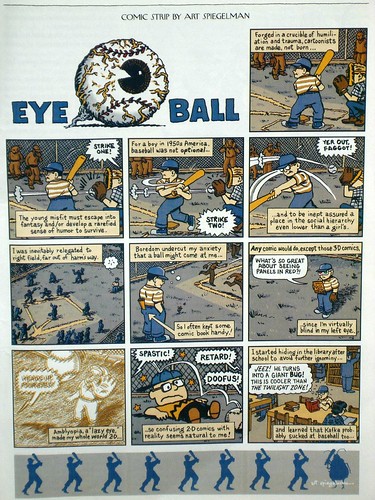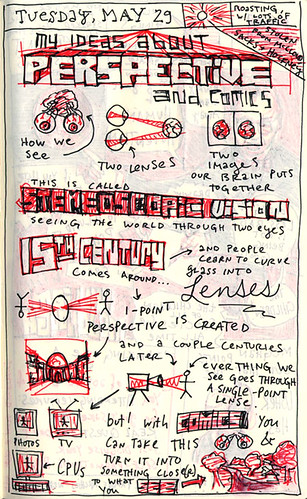“The resonances of losing stereoscopy can be unexpectedly far-reaching, causing not only a problem in judging depth and distance, but a “flattening” of the whole visual world, a flattening that is both perceptual and emotional. People in this situation speak of feeling “disconnected,” of a difficulty in relating themselves not only spatially but emotionally to what they are seeing. The return of binocular vision, if this occurs, can thus give great pleasure and relief, as the world once again seems visually and emotionally rich.
—Oliver Sacks, Musicophilia
Reading through Oliver Sacks’ Musicophilia, I was struck by the idea that it might be our deficiencies or our weaknesses that lead us to our talents.
Art Spiegelman has amblyopia, or lazy eye — he’s virtually blind in his left eye.
“[W]hich means that I don’t have binocular vision, and have difficulty seeing in three dimensions. This might have been part of what made me a cartoonist rather than a baseball player. I was rotten at sports, but I found that if I could draw good caricatures of the teachers I wouldn’t be doomed to be the butt of everybody’s scorn.”
Today I found a good scan of Spiegelman’s cartoon, “Eye Ball,” which originally ran in the New Yorker:
(Why such an interest in vision? I should note that I have poor eyesight, mild red/green colorblindness, and a grandmother with cataracts and glaucoma. I’m terrified of going blind!)
Ever since I read David Hockney’s Secret Knowledge, I’ve been very interested in binocular vision. Longtime readers might remember this sketchbook page from a post I did about the tyranny of linear perspective in comics:
Thinking about all this, I dug up an old New Yorker article by Oliver Sacks about stereoscopic vision (the article is called “Stereo Sue” — I’ll post the beginning in the comments below). Sacks talks about the discovery of stereoscopic vision, and then some alternatives for those who don’t have it:
There are, of course, many other ways of judging depth: occlusion of distant objects by closer objects, perspective (the fact that distant objects appear smaller), shading (which delineates the shape of objects), “aerial” perspective (the blurring and bluing of more distant objects by the intervening air), and, most important, motion parallax–the change of spatial relationships as we move our heads. All these cues, acting in tandem, can give a vivid sense of reality and space and depth. But the only way to actually perceive depth rather than judge it is with binocular stereoscopy.
And uh, well, I guess that’s all I’ve got on the subject at this point…


Stereo Sue
The New Yorker, 19-JUN-06
by Oliver Sacks
When Galen, in the second century, and Leonardo, thirteen centuries later, observed that the images received by the two eyes were slightly different, neither of them appreciated the full significance of these differences. It was not until the early eighteen-thirties that the English scientist and inventor Charles Wheatstone began to suspect that the disparities between the two retinal images were in fact crucial to the brain’s mysterious ability to generate a sensation of depth–and that the brain somehow fused these images automatically and unconsciously.
Wheatstone confirmed the truth of his conjecture by an experimental method as simple as it was brilliant. He made pairs of drawings of a solid object as seen from the slightly different perspectives of the two eyes, and then designed an instrument that used mirrors to insure that each eye saw only its own drawing. He called it a stereoscope, from the Greek for “solid vision.” If one looked into the stereoscope, the two flat drawings would fuse to produce a single three-dimensional drawing poised in space.
(One does not need a stereoscope to see stereo depth; it is relatively easy for most people to learn how to “free-fuse” such drawings, simply by diverging or converging the eyes. So it is strange that stereopsis was not discovered centuries before: Euclid or Archimedes could have drawn stereo diagrams in the sand, as David Hubel has remarked, and discovered stereopsis in the third century B.C. But they did not, as far as we know.)
A few years after Wheatstone’s discovery came the invention of photography, and stereophotographs, with their magical illusion of depth, became immensely popular. Queen Victoria herself was presented with a stereoscope after admiring one at the 1851 Great Exhibition, at the Crystal Palace, and soon no Victorian drawing room was complete without one. With the development of smaller, cheaper stereoscopes, easier photographic printing, and even stereo parlors, there were few people in Europe or America who did not have access to stereo viewers by the end of the nineteenth century.
With stereophotographs, viewers could see the monuments of Paris and London, or great sights of nature like Niagara Falls or the Alps, in all their majesty and depth–with an uncanny verisimilitude that made them feel as if they were hovering over the actual scenes. (By the mid-eighteen-fifties, a subspecialty of stereophotography, stereopornography, was already well established, though this was of a rather static type, because the photographic processes used at the time required lengthy exposures.)
In 1861, Oliver Wendell Holmes (who invented the popular handheld Holmes Stereo Viewer), in one of several Atlantic Monthly articles on stereoscopes, remarked on the special pleasure people seemed to derive from this magical illusion of depth:
The shutting out of surrounding objects, and the concentration of the whole attention . . . produces a dream-like exaltation . . . in which we seem to leave the body behind us and sail into one strange scene after another, like disembodied spirits.
There are, of course, many other ways of judging depth: occlusion of distant objects by closer objects, perspective (the fact that distant objects appear smaller), shading (which delineates the shape of objects), “aerial” perspective (the blurring and bluing of more distant objects by the intervening air), and, most important, motion parallax–the change of spatial relationships as we move our heads. All these cues, acting in tandem, can give a vivid sense of reality and space and depth. But the only way to actually perceive depth rather than judge it is with binocular stereoscopy.
In my boyhood home, in London, during the nineteen-thirties, we had two stereoscopes: a large, old-fashioned wooden one, which took glass slides, and a smaller, handheld one, which took cardboard stereophotographs. We also had books of bicolor anaglyphs–stereophotographs printed in different colors, which had to be viewed with a pair of red-and-green glasses that effectively restricted each eye to seeing only one of the images.
So when I developed a passion for photography, at the age of ten, I wanted, of course, to make my own pairs of stereophotos. This was easy to do, by moving the camera horizontally about two and a half inches between exposures, mimicking the distance between the two eyes. (I did not yet have a double-lens stereocamera, which would take simultaneous stereo pairs.)
I started taking pictures with greater and greater separations between them, and then, using a cardboard tube about a yard long and four little mirrors, I made a hyperstereoscope–turning myself, in effect, into a creature with eyes a yard apart. With this, I could look at even a very distant object, like the dome of St. Paul’s Cathedral, which normally appeared as a flat semicircle on the horizon, and see it in its full rotundity, projecting toward me. I also experimented with the opposite of this by making a pseudoscope (another device invented by Wheatstone), which transposed the views of the two eyes. This reversed the stereo effect to some extent, making distant objects appear closer than near ones, and turning faces into hollow masks, even though this contradicted common sense, and contradicted all the other depth cues of perspective and occlusion–a bizarre and disorienting experience as the brain struggled to reconcile two opposite conclusions, and alternated rapidly between rival hypotheses.
After the Second World War, new techniques and forms of stereoscopy became popular. The View-Master, a little stereoscope made of plastic, took reels of tiny Kodachrome transparencies that one flicked through by pressing a lever. I fell in love with faraway America at this time, partly through such View-Master reels of the grand scenery of the West and the Southwest.
One could also get Polaroid Vectographs, in which the stereo images were polarized at right angles to one another; these were viewed through a special pair of Polaroid glasses, with the polarization of the lenses also at right angles, insuring that each eye saw only its own image. Such Vectographs, unlike the red-and-green anaglyphs, could be in full color, which gave them a special appeal.
Then there were lenticular stereograms, in which the two images were printed in alternating narrow vertical bands covered by clear ridged plastic. The ridges served to transmit each set of images to the proper eye, eliminating the need for any special glasses. I first saw a lenticular stereogram just after the war, in the London Tube–an advertisement, as it happened, for Maidenform bras. I wrote to Maidenform, asking if I could have one of their advertisements, but got no reply; they must have imagined I was a sex-obsessed teen-ager, rather than a simple stereophile.
Finally, there was a slew of 3-D films (like the Madame Tussauds horror film, “House of Wax”), which one would look at through red-and-green or Polaroid glasses. As cinema, most of these were awful–but some, like “Inferno,” were very beautiful, and used stereophotography in an exquisite, delicate, unintrusive way.
Over the years, I amassed a collection of stereograms and books about stereoscopy. I am an active member of the New York Stereoscopic Society, and at their meetings I encounter other stereo buffs. Unlike most, we do not take stereoscopy for granted but revel in…
I’m a sucker for things about vision and optics, so I appreciated this post (haven’t read the Stereo Sue article yet). It’s a bit dry and technical in places, but you should check out the book “The Moving Tablet of the Eye”. It’s a history of vision research, spanning from Plato’s time to modern ocular tracking systems. It’s mostly about the movements that eyes make, but it touches on parallax viewing and stereo vision stuff too (unless I’m misremembering things). Lots of weird engravings and photographs of old medical devices, always a bonus.
In an ironic turn of events, Oliver Sacks has now lost his stereoscopic vision: